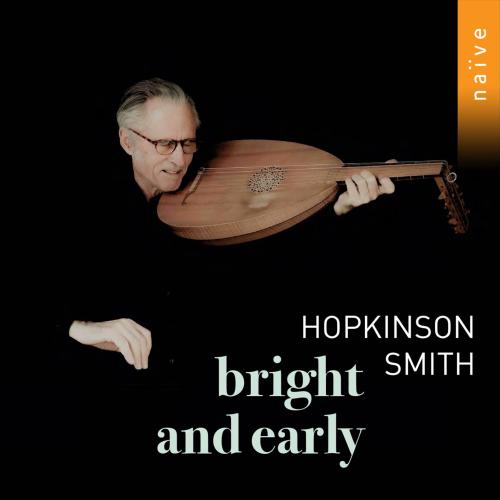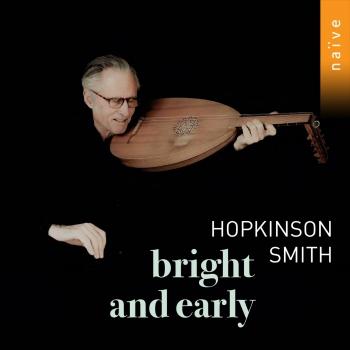
Bright & Early Hopkinson Smith
Album info
Album-Release:
2023
HRA-Release:
10.02.2023
Label: Naïve, a Label of Believe Group
Genre: Classical
Subgenre: Instrumental
Artist: Hopkinson Smith
Composer: Marchetto Cara (1465–1525), Joan Ambrosio Dalza (1508), Francesco Spinacino (1485-1507)
Album including Album cover Booklet (PDF)
I`m sorry!
Dear HIGHRESAUDIO Visitor,
due to territorial constraints and also different releases dates in each country you currently can`t purchase this album. We are updating our release dates twice a week. So, please feel free to check from time-to-time, if the album is available for your country.
We suggest, that you bookmark the album and use our Short List function.
Thank you for your understanding and patience.
Yours sincerely, HIGHRESAUDIO
- Joan Ambrosio Dalza (?-1508):
- 1 Dalza: Saltarello ala ferrarese (Intabulatura de lauto, Libro quarto) 03:40
- Francesco Spinacino (1485 - 1507):
- 2 Spinacino: Recercare 6 (Intabolatura de lauto, Libro primo, Libro secondo) 02:12
- 3 Spinacino: Recercare 13 (Intabolatura de lauto, Libro primo, Libro secondo) 02:24
- Joan Ambrosio Dalza:
- 4 Dalza: Piva ala ferrarese (Intabulatura de lauto, Libro quarto) 02:17
- 5 Dalza: Caldibi castigliano (Intabulatura de lauto, Libro quarto) 01:48
- 6 Dalza, Smith: Caldibi saltarello (Intabulatura de lauto, Libro quarto) 03:05
- Francesco Spinacino:
- 7 Spinacino: Recercare 23 (Intabolatura de lauto, Libro primo, Libro secondo) 03:33
- 8 Spinacino: Recercare 4 (Intabolatura de lauto, Libro primo, Libro secondo) 04:28
- Joan Ambrosio Dalza:
- 9 Dalza: Pavana ala ferrarese (Intabulatura de lauto, Libro quarto) 04:28
- Marchetto Cara (1465 - 1525):
- 10 Cara: Io non compro più speranza (Franciscus bossinensis, Libro primo) 03:03
- Joan Ambrosio Dalza:
- 11 Dalza: Poi che volse la mia stella (Intabulatura de lauto, Libro quarto) 02:30
- Francesco Spinacino:
- 12 Spinacino: Recercare 25 (Intabolatura de lauto, Libro primo, Libro secondo) 02:31
- 13 Spinacino: Recercare 15 (Intabolatura de lauto, Libro primo, Libro secondo) 03:20
- Joan Ambrosio Dalza:
- 14 Dalza: Pavana ala venetiana (Intabulatura de lauto, Libro quarto) 03:53
- 15 Dalza: Saltarelloala venetiana (Intabulatura de lauto, Libro quarto) 01:51
- 16 Dalza: Piva ala venetiana (Intabulatura de lauto, Libro quarto) 03:13
- Francesco Spinacino:
- 17 Spinacino: Recercare 12 (Intabolatura de lauto, Libro primo, Libro secondo) 03:24
- 18 Spinacino: Recercare 9 (Intabolatura de lauto, Libro primo, Libro secondo) 04:03
- Joan Ambrosio Dalza:
- 19 Dalza: Poi che'l ciel contrario adverso (Intabulatura de lauto, Libro quarto) 02:15
- 20 Dalza: Calata ala spagnola ditto terzetti di zuan Ambroso Dalza (Intabulatura de lauto, Libro quarto) 05:18
- 21 Dalza: Tastar de corde (Intabulatura de lauto, Libro quarto) 01:18
Info for Bright & Early
The “supreme poet of the lute” (Gramophone), Hopkinson Smith creates a subtle, intimate dialogue between Dalza and Spinacino, witnesses of the instrument’s flourishing culture in Italy at the dawn of the 16th Century.
Hopkinson Smith, that indefatigable pioneer for over forty years, eager hunter of the most distant scores and defender of restoring often obscure manuscripts, will stop at nothing in his exploration and revival of the huge repertoire of his instrument. In this recording, his art, underpinned by a vast historic knowledge together with a profound faith in intuition, examines the first music printed for the lute, and some of the first sources for the instrument to have reached us.
In a perfectly symmetrical programme structured around a central piece by Marchetto Cara, the Swiss American lutenist intertwines pieces inspired from popular dance by Joan Ambrosio Dalza and several free form ricercari by Francesco Spinacino, taken from collections of tablatures published in Venice in 1507 and 1508.
“Some critics may see my reconstruction of the music as heresy, but I considered it necessary, given the degree of confusion in which many of Spinacino’s works have reached us,” warns Hopkinson Smith. “I believed we had to either abandon the originals to their fate, never to be played, or tighten the loose threads of a convincing tapestry as a work of art.”
He weaves this subtle polyphony on a six-course lute built in the tradition of the late 15th Century, giving it heightened resonance and clarity of sound. Inspired by the mystery of these mysterious treasures evoking the distant times and reverie of the Middle Ages, Hopkinson Smith approaches these works with the humility of one who appreciates the incredible richness, and the expressive power of this solitary lutenist who has become a storyteller through his instrument.
Hopkinson Smith, lute
Hopkinson Smith
Born in New York in 1946, Swiss-American lutenist Hopkinson Smith graduated from Harvard with Honors in Music in 1972. His instrumental studies took him to Europe where he worked with Emilio Pujol, a great pedagogue in the highest Catalan artistic tradition, and with the Swiss lutenist, Eugen Dombois, whose sense of organic unity between performer, instrument, and historical period has had lasting effects on him. He has been involved in numerous chamber music projects and was one of the founding members of the ensemble Hespèrion XX. Since the mid-80’s, he has focused almost exclusively on the solo repertoires for early plucked instrument, producing a series of prize-winning recordings for Astrée and Naïve, which feature Spanish music for vihuela and baroque guitar, French lute music of the Renaissance and baroque, English and Italian music of the 16th early 17th century and music from the German high baroque.
The recording of his lute arrangements of the Bach solo violin Sonatas and Partitas, released in the year 2000, has been universally acclaimed by the press. Gramophone magazine called it “the best recording of these works on any instrument”. A Dowland recording, released in early 2005, won a Diapason d’Or and was called ‘wonderfully personal’ in a review in the New York Times. A recording with music from the world of Francesco da Milano, was awarded a Diapason d’Or de l’Année (the French equivalent of a Grammy award) in November 2009 and has been called “the first recording to do justice to Francesco’s reputation.” A CD with the first three Bach Cello Suites played on the German Theorbo was released in early 2013, has also won a Diapason d’Or and was called “totally riveting” in the BBC Music Magazine.
Hopkinson Smith has performed and given master classes throughout Eastern and Western Europe, North and South America, Australia, New Zealand, Korea and Japan sometimes combining the life-style of a hermit with that of a gypsy. In 2007 and 2009, he gave concerts and workshops in Palestine under the auspices of the Barenboim-Said Foundation and the Swiss Arts Council. In 2010, he received the music prize from the Italian Region of Puglia with the inscription “maestro dei maestri, massimo interprete delle musiche per liuto dell’antica Europa Mediterranea”. He lives in Basel, Switzerland where he teaches at the Schola Cantorum Basiliensis.
Booklet for Bright & Early












